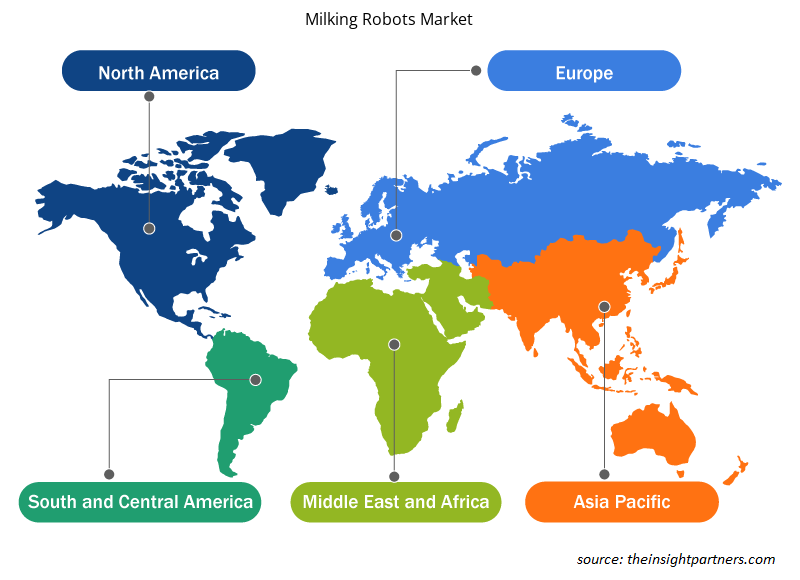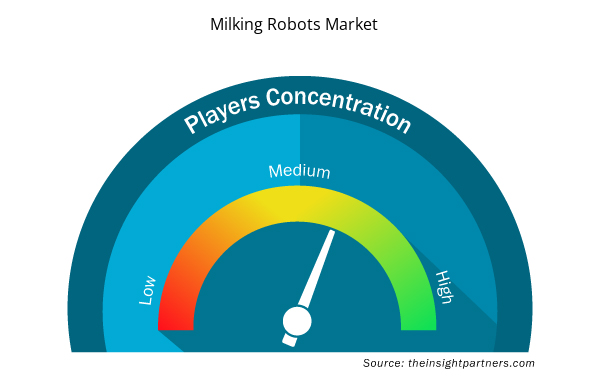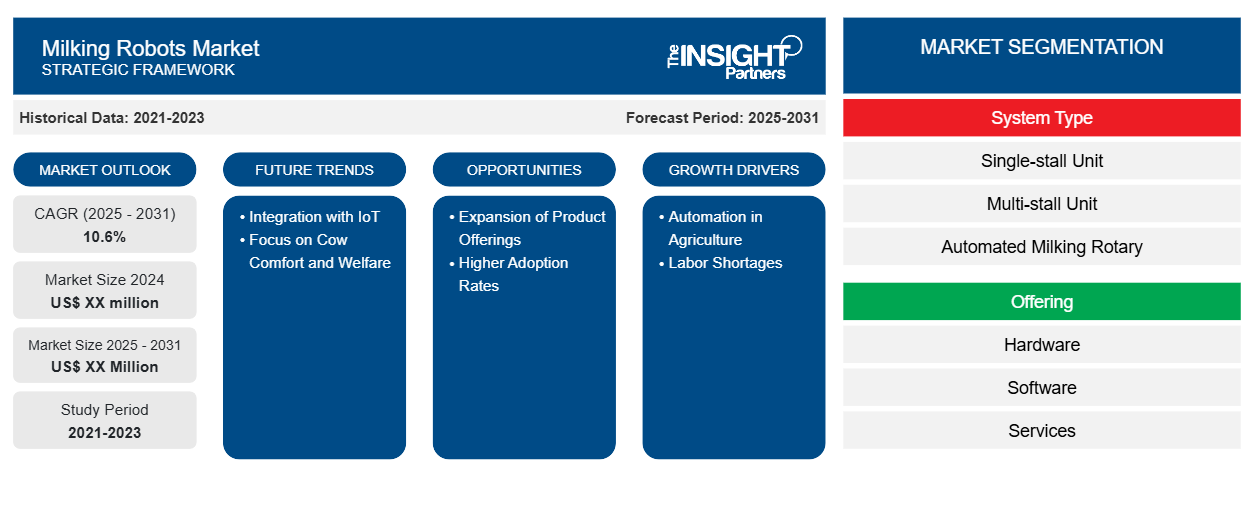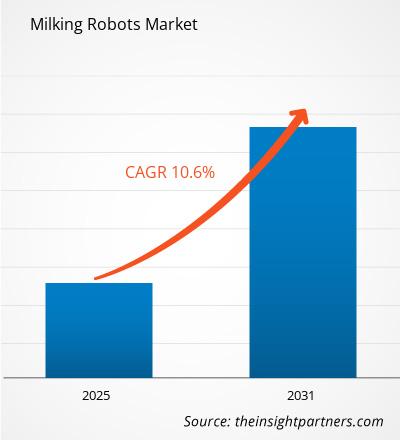Se espera que el mercado de robots de ordeño registre una CAGR del 10,6 % entre 2024 y 2031, con un tamaño de mercado que se expandirá de US$ XX millones en 2024 a US$ XX millones en 2031.
El informe está segmentado por tipo de sistema (unidad de un solo puesto, unidad de varios puestos, ordeño rotativo automatizado (AMR)), oferta (hardware, software, servicios), tamaño del rebaño (menos de 100, entre 100 y 1000, más de 1000), especie (ganado lechero, cabras, ovejas), actuadores (actuadores eléctricos, actuadores hidráulicos, actuadores neumáticos). El análisis global se desglosa aún más a nivel regional y por países principales. El informe ofrece el valor en USD para el análisis y los segmentos anteriores.
Propósito del Informe
El informe Milking Robots Market de The Insight Partners tiene como objetivo describir el panorama actual y el crecimiento futuro, los principales factores impulsores, los desafíos y las oportunidades. Esto proporcionará información a diversas partes interesadas del negocio, como:
- Proveedores/fabricantes de tecnología: Para comprender la dinámica cambiante del mercado y conocer las oportunidades potenciales de crecimiento, lo que les permitirá tomar decisiones estratégicas informadas.
- Inversionistas: Realizar un análisis exhaustivo de tendencias sobre la tasa de crecimiento del mercado, las proyecciones financieras del mercado y las oportunidades que existen en toda la cadena de valor.
- Órganos reguladores: Regular las políticas y vigilar las actividades del mercado con el objetivo de minimizar los abusos, preservar la confianza de los inversores y defender la integridad y la estabilidad del mercado.
Segmentación del mercado de robots de ordeño
Tipo de sistema
- Unidad de un solo puesto
- Unidad de múltiples puestos
- Ordeño rotativo automatizado
Ofrenda
- Hardware
- Software
- Servicios
Tamaño del rebaño
- Por debajo de 100
- Entre 100 y 1
- 000
- Arriba 1
- 000
Especies
- Vacas lecheras
- Cabra
- Oveja
Actuadores
- Actuadores eléctricos
- Actuadores hidráulicos
- Actuadores neumáticos
Personalice este informe según sus necesidades
Obtendrá personalización en cualquier informe, sin cargo, incluidas partes de este informe o análisis a nivel de país, paquete de datos de Excel, así como también grandes ofertas y descuentos para empresas emergentes y universidades.
- Obtenga las principales tendencias clave del mercado de este informe.Esta muestra GRATUITA incluirá análisis de datos, desde tendencias del mercado hasta estimaciones y pronósticos.
Factores impulsores del crecimiento del mercado de robots de ordeño
- Automatización en la agricultura: Las crecientes demandas de automatización en la industria agrícola están impulsando significativamente el mercado de robots de ordeño. Las granjas lecheras, que enfrentan crecientes demandas de producción y un deseo cada vez mayor de eficiencia, están recurriendo a tecnologías avanzadas como los robots de ordeño. Estas máquinas mejoran la producción de leche además de garantizar un mejor bienestar para los animales, en particular las vacas, al ordeñarlas en un entorno libre de estrés. Estas tecnologías se han adoptado como un reflejo de la tendencia más amplia de mecanización en la agricultura, donde los métodos más tradicionales se transforman para ser reemplazados por soluciones más innovadoras que no solo optimizan todo el proceso de producción de alimentos, sino que también garantizan la calidad y la sostenibilidad necesarias para la creciente demanda mundial de productos lácteos.
- Escasez de mano de obra: La otra razón principal por la que los robots de ordeño tienen más probabilidades de ganar aceptación es la escasez crónica de mano de obra en el sector lechero. Hoy en día, la mayoría de las granjas tienen dificultades para reunir suficiente mano de obra calificada para llevar a cabo sus operaciones con éxito. Por lo tanto, los robots de ordeño ofrecen una forma práctica de resolver el problema al permitir a los agricultores manejar rebaños más grandes sin aumentar el número de personas. Permiten un ordeño más eficiente, liberando así recursos humanos en otras partes de la granja donde se necesitan sus servicios. Con los robots de ordeño, los desafíos laborales se abordan con una relación costo-beneficio que mejora la productividad en general. La decisión de integrar tales tecnologías ayuda a mantener la competitividad de las granjas lecheras en el contexto de un cambio rápido en el panorama agrícola.
Tendencias futuras del mercado de robots de ordeño
- Integración con IoT: Se cree que un robot de ordeño conectado a IoT revolucionará el sector de la producción lechera al aumentar la eficiencia en las operaciones. Un robot de ordeño habilitado con IoT proporcionará datos en tiempo real sobre cada aspecto de la granja lechera: tasa de producción de leche, salud de las vacas y rendimiento general del rebaño. De este modo, la gestión basada en datos garantizará un seguimiento cercano de los sistemas y decisiones oportunas y bien informadas basadas en información precisa que brinden. Por ejemplo, las alertas en tiempo real informarán al ganadero de cualquier anomalía en los ordeños u otras condiciones de salud animal para permitir intervenciones oportunas. En última instancia, la integración real conducirá a una gestión lechera eficiente al tiempo que maximizará la productividad y mejorará el bienestar animal para poner a las granjas en camino de operaciones efectivas dentro de mercados competitivos.
- Atención a la comodidad y el bienestar de las vacas: los robots de ordeño modernos están diseñados con énfasis en la comodidad y el bienestar de las vacas. Están equipados con características como un manejo suave de las ubres, entornos de bajo estrés y horarios de ordeño individualizados. Este enfoque no solo mejora el bienestar de los animales, sino que también aumenta la producción y la calidad de la leche, lo que hace que el ordeño automatizado sea más sostenible.
Oportunidades de mercado para robots de ordeño
- Ampliación de la oferta de productos: La ampliación de la oferta de productos es un enfoque estratégico que muchas empresas implicadas en el mercado de robots de ordeño buscan abordar mediante adquisiciones y asociaciones. En este sentido, con la adquisición de SAC, BouMatic ha adquirido sistemas de ordeño considerablemente más amplios en cuanto a gama de productos que antes y, por tanto, podría cubrir un espectro más amplio de necesidades en la industria láctea. Esta ampliación no solo mejoraría la cartera de productos de la empresa, sino que también la situaría en una posición que le permitiría satisfacer mejor los diversos requisitos de los clientes. Unas soluciones de ordeño más amplias animarán a las empresas a innovar y mejorar la oferta de servicios para los clientes, lo que se traducirá en una mayor satisfacción y fidelidad de los clientes. Por tanto, se trata de un compromiso con el crecimiento y la flexibilidad en un mercado competitivo.
- Mayores tasas de adopción: Se prevé que la adopción se disparará una vez que se hagan evidentes más beneficios de la automatización. Cada vez más productores lecheros se están dando cuenta de cómo estas tecnologías podrían mejorar la eficiencia operativa, garantizar una mejor calidad de la leche y reducir los costos laborales. Es muy probable que la concienciación entre los productores lecheros mejore aún más mediante políticas gubernamentales adecuadas y beneficios que ayuden a modernizar la agricultura. Este apoyo puede facilitar la inversión de los productores en robots de ordeño, acelerando así la adopción de estos. A medida que la industria crezca, la integración de sistemas automatizados será la norma, cambiando el panorama de las granjas lecheras y asegurando que los productores estarán en igualdad de condiciones para hacer frente a los cambios dentro del mercado.
Perspectivas regionales del mercado de robots de ordeño
Los analistas de Insight Partners han explicado detalladamente las tendencias y los factores regionales que influyen en el mercado de robots de ordeño durante el período de pronóstico. Esta sección también analiza los segmentos y la geografía del mercado de robots de ordeño en América del Norte, Europa, Asia Pacífico, Oriente Medio y África, y América del Sur y Central.

- Obtenga datos regionales específicos para el mercado de robots de ordeño
Alcance del informe de mercado de robots de ordeño
| Atributo del informe | Detalles |
|---|---|
| Tamaño del mercado en 2024 | XX millones de dólares estadounidenses |
| Tamaño del mercado en 2031 | US$ XX millones |
| CAGR global (2024 - 2031) | 10,6% |
| Datos históricos | 2021-2023 |
| Período de pronóstico | 2025-2031 |
| Segmentos cubiertos | Por tipo de sistema
|
| Regiones y países cubiertos | América del norte
|
| Líderes del mercado y perfiles de empresas clave |
|
Densidad de actores del mercado de robots de ordeño: comprensión de su impacto en la dinámica empresarial
El mercado de robots de ordeño está creciendo rápidamente, impulsado por la creciente demanda de los usuarios finales debido a factores como la evolución de las preferencias de los consumidores, los avances tecnológicos y una mayor conciencia de los beneficios del producto. A medida que aumenta la demanda, las empresas amplían sus ofertas, innovan para satisfacer las necesidades de los consumidores y aprovechan las tendencias emergentes, lo que impulsa aún más el crecimiento del mercado.
La densidad de actores del mercado se refiere a la distribución de las empresas o firmas que operan dentro de un mercado o industria en particular. Indica cuántos competidores (actores del mercado) están presentes en un espacio de mercado determinado en relación con su tamaño o valor total de mercado.
Las principales empresas que operan en el mercado de robots de ordeño son:
- Sociedad Limitada.
- BouMatic
- MAESTRO LECHERO
- De Laval
- Paquete Fullwood
Descargo de responsabilidad : Las empresas enumeradas anteriormente no están clasificadas en ningún orden particular.

- Obtenga una descripción general de los principales actores clave del mercado de robots de ordeño
Puntos de venta clave
- Cobertura integral: el informe cubre de manera integral el análisis de productos, servicios, tipos y usuarios finales del mercado de robots de ordeño, proporcionando un panorama holístico.
- Análisis de expertos: el informe se compila sobre la base de un profundo conocimiento de expertos y analistas de la industria.
- Información actualizada: El informe asegura relevancia comercial debido a su cobertura de información reciente y tendencias de datos.
- Opciones de personalización: este informe se puede personalizar para satisfacer los requisitos específicos del cliente y adaptarse adecuadamente a las estrategias comerciales.
Por lo tanto, el informe de investigación sobre el mercado de robots de ordeño puede ayudar a abrir camino para descifrar y comprender el escenario de la industria y las perspectivas de crecimiento. Si bien puede haber algunas preocupaciones válidas, los beneficios generales de este informe tienden a superar las desventajas.
- Análisis histórico (2 años), año base, pronóstico (7 años) con CAGR
- Análisis PEST y FODA
- Tamaño del mercado Valor/volumen: global, regional, nacional
- Industria y panorama competitivo
- Conjunto de datos de Excel


- Electronic Data Interchange Market
- Aerospace Forging Market
- Explosion-Proof Equipment Market
- Passport Reader Market
- Occupational Health Market
- Adaptive Traffic Control System Market
- Dried Blueberry Market
- Vessel Monitoring System Market
- Fishing Equipment Market
- Lyophilization Services for Biopharmaceuticals Market

Report Coverage
Revenue forecast, Company Analysis, Industry landscape, Growth factors, and Trends

Segment Covered
This text is related
to segments covered.

Regional Scope
North America, Europe, Asia Pacific, Middle East & Africa, South & Central America

Country Scope
This text is related
to country scope.
Preguntas frecuentes
-
Some of the customization options available based on the request are an additional 3-5 company profiles and country-specific analysis of 3-5 countries of your choice. Customizations are to be requested/discussed before making final order confirmation as our team would review the same and check the feasibility
Integration with IoT is anticipated to play a significant role in the global milking robots market in the coming years
The report can be delivered in PDF/PPT format; we can also share excel dataset based on the request
The major factors driving the milking robots market are:
1. Automation in Agriculture
2. Labor Shortages
The Milking Robots Market is estimated to witness a CAGR of 10.6% from 2023 to 2031
Trends and growth analysis reports related to Electronics and Semiconductor : READ MORE..
1. Afimilk Ltd.
2. BouMatic
3. DAIRYMASTER
4. DeLaval
5. Fullwood Packo
6. GEA Group
7. Hokofarm Group B.V.
8. Lely
9. SCR
10. Waikato Milking Systems LP
The Insight Partners performs research in 4 major stages: Data Collection & Secondary Research, Primary Research, Data Analysis and Data Triangulation & Final Review.
- Data Collection and Secondary Research:
As a market research and consulting firm operating from a decade, we have published and advised several client across the globe. First step for any study will start with an assessment of currently available data and insights from existing reports. Further, historical and current market information is collected from Investor Presentations, Annual Reports, SEC Filings, etc., and other information related to company’s performance and market positioning are gathered from Paid Databases (Factiva, Hoovers, and Reuters) and various other publications available in public domain.
Several associations trade associates, technical forums, institutes, societies and organization are accessed to gain technical as well as market related insights through their publications such as research papers, blogs and press releases related to the studies are referred to get cues about the market. Further, white papers, journals, magazines, and other news articles published in last 3 years are scrutinized and analyzed to understand the current market trends.
- Primary Research:
The primarily interview analysis comprise of data obtained from industry participants interview and answers to survey questions gathered by in-house primary team.
For primary research, interviews are conducted with industry experts/CEOs/Marketing Managers/VPs/Subject Matter Experts from both demand and supply side to get a 360-degree view of the market. The primary team conducts several interviews based on the complexity of the markets to understand the various market trends and dynamics which makes research more credible and precise.
A typical research interview fulfils the following functions:
- Provides first-hand information on the market size, market trends, growth trends, competitive landscape, and outlook
- Validates and strengthens in-house secondary research findings
- Develops the analysis team’s expertise and market understanding
Primary research involves email interactions and telephone interviews for each market, category, segment, and sub-segment across geographies. The participants who typically take part in such a process include, but are not limited to:
- Industry participants: VPs, business development managers, market intelligence managers and national sales managers
- Outside experts: Valuation experts, research analysts and key opinion leaders specializing in the electronics and semiconductor industry.
Below is the breakup of our primary respondents by company, designation, and region:

Once we receive the confirmation from primary research sources or primary respondents, we finalize the base year market estimation and forecast the data as per the macroeconomic and microeconomic factors assessed during data collection.
- Data Analysis:
Once data is validated through both secondary as well as primary respondents, we finalize the market estimations by hypothesis formulation and factor analysis at regional and country level.
- Macro-Economic Factor Analysis:
We analyse macroeconomic indicators such the gross domestic product (GDP), increase in the demand for goods and services across industries, technological advancement, regional economic growth, governmental policies, the influence of COVID-19, PEST analysis, and other aspects. This analysis aids in setting benchmarks for various nations/regions and approximating market splits. Additionally, the general trend of the aforementioned components aid in determining the market's development possibilities.
- Country Level Data:
Various factors that are especially aligned to the country are taken into account to determine the market size for a certain area and country, including the presence of vendors, such as headquarters and offices, the country's GDP, demand patterns, and industry growth. To comprehend the market dynamics for the nation, a number of growth variables, inhibitors, application areas, and current market trends are researched. The aforementioned elements aid in determining the country's overall market's growth potential.
- Company Profile:
The “Table of Contents” is formulated by listing and analyzing more than 25 - 30 companies operating in the market ecosystem across geographies. However, we profile only 10 companies as a standard practice in our syndicate reports. These 10 companies comprise leading, emerging, and regional players. Nonetheless, our analysis is not restricted to the 10 listed companies, we also analyze other companies present in the market to develop a holistic view and understand the prevailing trends. The “Company Profiles” section in the report covers key facts, business description, products & services, financial information, SWOT analysis, and key developments. The financial information presented is extracted from the annual reports and official documents of the publicly listed companies. Upon collecting the information for the sections of respective companies, we verify them via various primary sources and then compile the data in respective company profiles. The company level information helps us in deriving the base number as well as in forecasting the market size.
- Developing Base Number:
Aggregation of sales statistics (2020-2022) and macro-economic factor, and other secondary and primary research insights are utilized to arrive at base number and related market shares for 2022. The data gaps are identified in this step and relevant market data is analyzed, collected from paid primary interviews or databases. On finalizing the base year market size, forecasts are developed on the basis of macro-economic, industry and market growth factors and company level analysis.
- Data Triangulation and Final Review:
The market findings and base year market size calculations are validated from supply as well as demand side. Demand side validations are based on macro-economic factor analysis and benchmarks for respective regions and countries. In case of supply side validations, revenues of major companies are estimated (in case not available) based on industry benchmark, approximate number of employees, product portfolio, and primary interviews revenues are gathered. Further revenue from target product/service segment is assessed to avoid overshooting of market statistics. In case of heavy deviations between supply and demand side values, all thes steps are repeated to achieve synchronization.
We follow an iterative model, wherein we share our research findings with Subject Matter Experts (SME’s) and Key Opinion Leaders (KOLs) until consensus view of the market is not formulated – this model negates any drastic deviation in the opinions of experts. Only validated and universally acceptable research findings are quoted in our reports.
We have important check points that we use to validate our research findings – which we call – data triangulation, where we validate the information, we generate from secondary sources with primary interviews and then we re-validate with our internal data bases and Subject matter experts. This comprehensive model enables us to deliver high quality, reliable data in shortest possible time.


 Obtenga una muestra gratuita de este informe
Obtenga una muestra gratuita de este informe